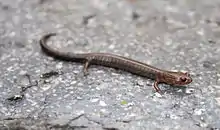Northern ravine salamander
The northern ravine salamander (Plethodon electromorphus) is a species of salamander in the family Plethodontidae endemic to the United States. It has been found in Indiana, Ohio, Kentucky, Pennsylvania and West Virginia. Its natural habitats are temperate forests and rocky areas. The species is listed as Least Concern on the IUCN Red List of Threatened Species.[1]
| Northern ravine salamander | |
|---|---|
 | |
| Scientific classification | |
| Kingdom: | Animalia |
| Phylum: | Chordata |
| Class: | Amphibia |
| Order: | Urodela |
| Family: | Plethodontidae |
| Subfamily: | Plethodontinae |
| Genus: | Plethodon |
| Species: | P. electromorphus |
| Binomial name | |
| Plethodon electromorphus Highton, 1999 | |
Description
The northern ravine salamander is a small terrestrial salamander, 7.5 – 11.5 cm (3.0 – 4.5 in) in total length. They are elongated, slender, and short-legged. Their coloration is brown to nearly black, sprinkled with minute silvery white and bronzy or brassy specks. They have very small, irregular white blotches on lower sides, and a virtually plain dark belly with a lightly mottled chin.[2]
Taxonomy
Previously considered to be a part of Plethodon richmondi (southern ravine salamanders), electrophoresis, from which the name electromorphus is derived, was used to distinguish them.[3]
Behavior
Northern ravine salamanders are less aggressive than the more widespread Plethodon cinereus (red-backed salamander).[4]
References
- IUCN SSC Amphibian Specialist Group 2014. Plethodon electromorphus. The IUCN Red List of Threatened Species 2014: e.T59338A56366748. Downloaded on 16 April 2020.
- Powell, Robert (2016). Peterson Field Guide to Reptiles and Amphibians of Eastern and Central North America, Fourth Edition. Boston: Houghton Mifflin. p. 81. ISBN 978-0544129979.
- Highton (1999). Hybridization in the Contact Zone between Plethodon richmondi and Plethodon electromorphus in Northern Kentucky. Herpetologica 55, 91-105. Retrieved 16 April 2020
- Deitloff, J., Church, J. O., Adams, D. C. & Jaeger, R. G. (2009) Interspecific Agonistic Behaviors in a Salamander Community: Implications for Alpha Selection. Herpetologica 65, 174–182.
